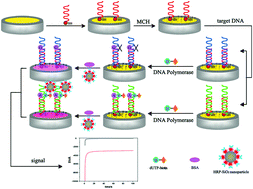An electrochemical sensor based on DNA polymerase and HRP-SiO2 nanoparticles for the ultrasensitive detection of K-ras gene point mutation†
Abstract
We successfully developed an electrochemical DNA sensor for the precise detection of K-ras gene point mutation. The proposed sensor was based on DNA replication, which fully employed the 5′ → 3′ polymerization activity of DNA polymerase I and the principle of base pairing. The biotin-dUTP only linked with the base A, instead of base G. And then, the streptavidin-HRP-SiO2 nanoparticles combining with the biotin-dUTP on the modified electrode produced the current signal in the TMB solution. The streptavidin-HRP-SiO2 nanoparticles had the effect of amplified signal. Hence, the sensitivity and selectivity of the proposed sensor were observably enhanced, comparison with the previously reported DNA sensors. The response current of the amperometric i–t curve of the prepared sensor showed a good linear correlation with the logarithm of target DNA concentration in the range from 0.001 pM to 1000 pM with the limit of detection of 0.42 fM. And the current value was also proportional to the logarithm of target DNA concentration from 0.01 pM to 100 pM when the hybridization solution contained other mutant K-ras genes and wild K-ras gene. Thus, this proposed approach provided the good basis and a promising platform that the mutant K-ras gene in the clinical genomic sample can be directly detected.


 Please wait while we load your content...
Please wait while we load your content...